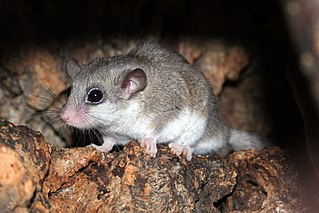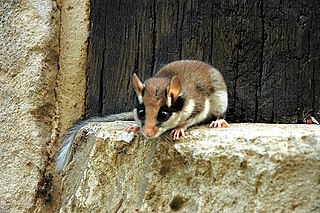
A dormouse is a rodent of the family Gliridae. Dormice are nocturnal animals found in Africa, Asia, and Europe. They are named for their long, dormant hibernation period of six months or longer.

The European edible dormouse also known as the European dormouse or European fat dormouse is a large dormouse and one of only two living species in the genus Glis, found in most of Europe and parts of western Asia. The common name comes from the Romans, who ate them as a delicacy.

The hazel dormouse or common dormouse is a small dormouse species native to Europe and the only living species in the genus Muscardinus.

The Balkan snow vole, also known as Martino's snow vole, is the only living member of the genus Dinaromys. The genus name means "Dinaric mouse", referring to the Dinaric Alps, as the species is endemic to the western Balkans of southeast Europe. Eight subspecies of this vole have been recognized, although in 2022 this number was reduced to two subspecies. The Balkan snow vole is a living fossil, the only living species in the tribe Pliomyini, and might arguably better be placed in Pliomys, a genus established for its fossil relatives even before the Balkan snow vole was scientifically described. It was described by husband and wife mammalogists Vladimir Emmanuilovich Martino and Evgeniya Veniaminovna Martino. Others have argued that Pliomys should be treated as entirely separate from Dinaromys, with Dinaromys and P. lenki estimated to have genetically diverged around 4 million years ago based on ancient DNA sequences. The earliest representatives of Dinaromys like Dinaromys allegranzii date to the Early Pleistocene, with Dinaromys also inhabiting the Italian Peninsula until the end of the Late Pleistocene, when it contracted to its current distribution.

Eliomys is a genus of Palaearctic rodents in the family Gliridae, commonly known as garden dormice.
The masked mouse-tailed dormouse, also called Ognev's mouse-tailed dormouse, is a species of rodent in the family Gliridae. It is found in Iran and Turkmenistan.

The Roach's mouse-tailed dormouse or ground dormouse, also known simply as the mouse-tailed dormouse, is a species of rodent in the family Gliridae. It is found in Bulgaria, European Turkey, and Greece.
The desert dormouse is a species of rodent in the dormouse family, Gliridae. This species was formerly placed in its own family, Seleviniidae, but it is now considered to be a dormouse, monotypic within the genus Selevinia. It is endemic to Kazakhstan.

Leithiinae is a subfamily of dormice. It is named after the Leithia, an extinct genus of giant dormouse from the Pleistocene of Sicily.

The Glirinae are a subfamily of dormice (Gliridae); it contains two extant genera, one being monotypic and the other containing two species:

Hypnomys, otherwise known as Balearic giant dormice, is an extinct genus of dormouse (Gliridae) in the subfamily Leithiinae. Its species are considered examples of insular gigantism. They were endemic to the Balearic Islands in the western Mediterranean from the Early Pliocene until their extinction around the 3rd millennium BC. They first appeared in the fossil record on Mallorca during the Early Pliocene, presumably as a result to the evaporation of the Mediterranean sea during the Messinian salinity crisis connecting the Balearic Islands with mainland Europe. They later spread to Menorca, and a possible molar is also known from Ibiza. Hypnomys became extinct during the late Holocene likely shortly after human arrival on the Balearics. They were one of only three native land mammals to the islands at the time of human arrival, alongside the shrew Nesiotites and goat-antelope Myotragus.

Leithia is an extinct genus of giant dormice from the Pleistocene of the Mediterranean islands of Malta and Sicily. It is considered an example of island gigantism. Leithia melitensis is the largest known species of dormouse, living or extinct, being twice the size of any other known species.
Walter Verheyen's African dormouse is a monotypic species of rodent in the family Gliridae. From the Central Congolian lowland forests ecoregion in the central Congo Basin, it has been found in west-central Democratic Republic of the Congo, in the vicinity of the Lukenie River and of Wafania, near the left bank of the Luilaka River. Although not found in immediate association, Lorraine's dormouse and the short-eared African dormouse are understood to be "broadly sympatric". Most closely resembling Jentink's dormouse, it differs from this species both in its much smaller size and in its relative proportions. On the IUCN Red List, its conservation status has been assessed as Data Deficient.
The Iranian edible dormouse or Iranian fat dormouse is a species of dormouse native to Western and Central Asia. It is one of only two species in the genus Glis.










